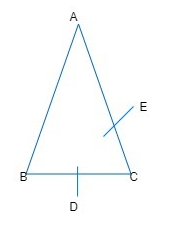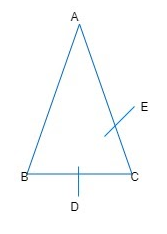Question
Question: Three charges each have \( +q \) charge, are placed at the corner of an isosceles triangle ABC of si...
Three charges each have +q charge, are placed at the corner of an isosceles triangle ABC of sides BC and AC, 2a.D and E are the mid points of BC and CA. The work done in taking a charge Q from D to E is:

(A) 8π∈0aeqQ
(B) 4π∈0aqQ
(C) Zero
(D) 4π∈0a3qQ
Solution
To find out the work done is taking charge Q from one point to another, we will find electrostatic potential at those points using
V=4π∈0rq
V is the potential generated between the charges
q is the charge due to which our test charge is affected
r is the distance between the charges.
Complete step by step solution

Here,
AC=BC=2a
As D and E are midpoints of BC and AC (given).
∴ AE=EC=a
And,
BD=DC=a
In ΔADC,
(AD)2=(AC)2−(DC)2=(2a)2−(a)2=(4a)2−(a)2=(a)2AD=a3
Similarly, potential at points D due to the given charge distribution is
VD=4π∈01[BDq+DCq+ADq]
=4π∈0q[a1+a1+3a1]=4π∈0aq[2+31] ...........................(1)
Potential at point E due to given charge configuration is
VE=4π∈01[q1+q1+a31]
=4π∈0aq[2+31] ...........................(2)
From (1) and (2), it is clear that
The work done in taking a charge Q from D to E is
W=Q(VE−VD)=0 (∵VD=VE)
Therefore, option (C) is correct.
Note
Electric potential due to single charge is spherically symmetric. It should be clearly borne in mind that due to single charge,
F∝r21 ; E∝r21 but V∝r1 ,
where r is the distance from the charge.
